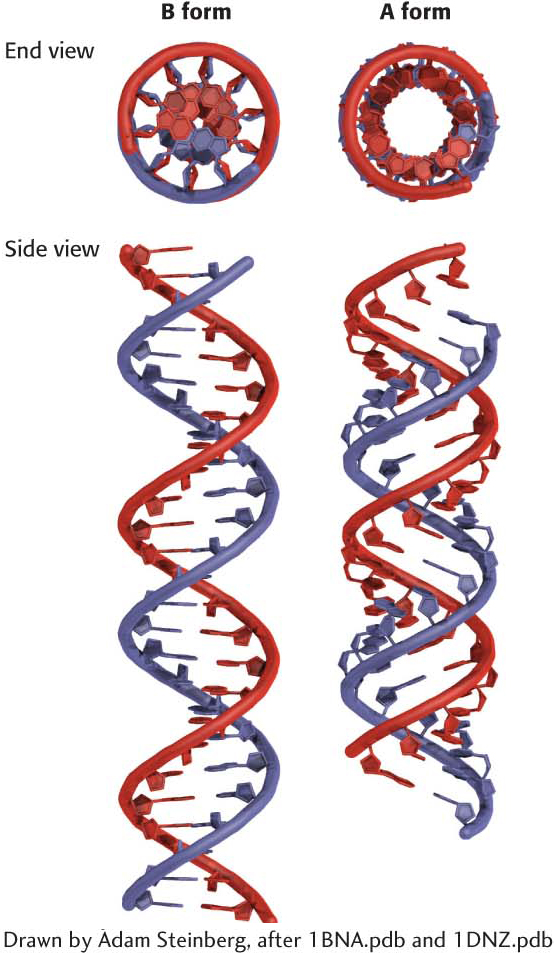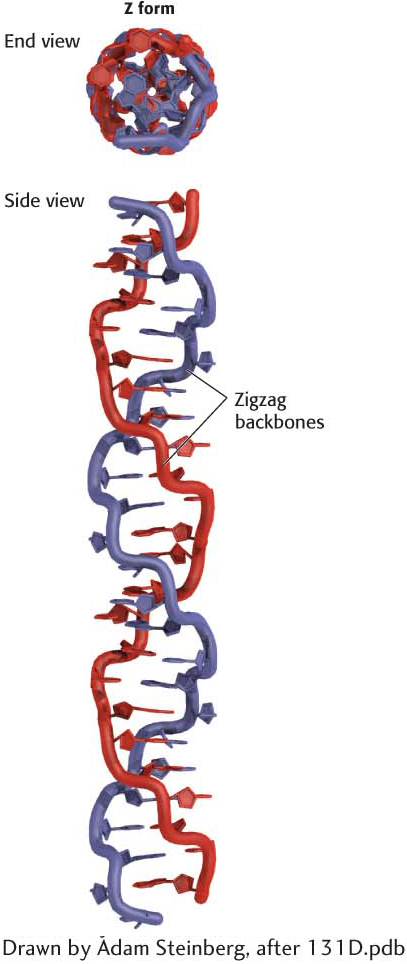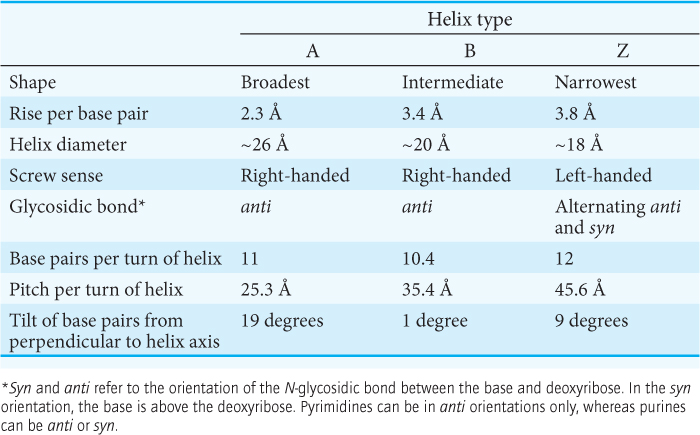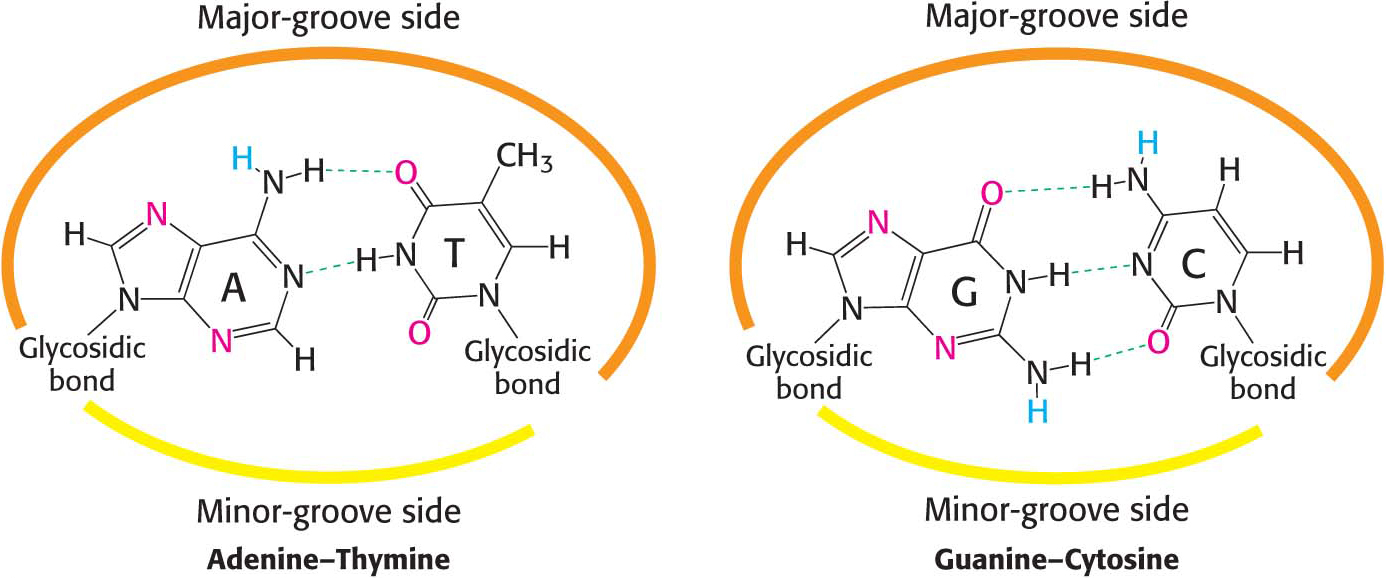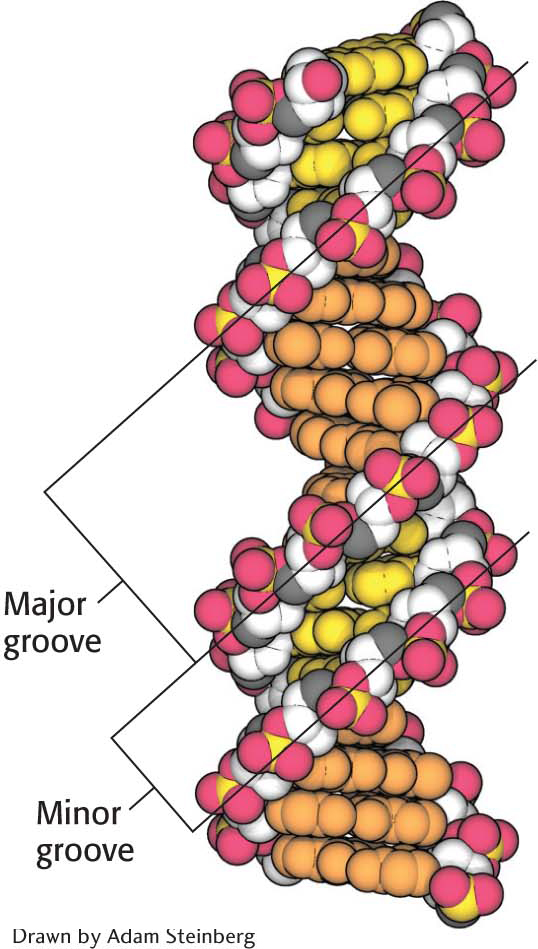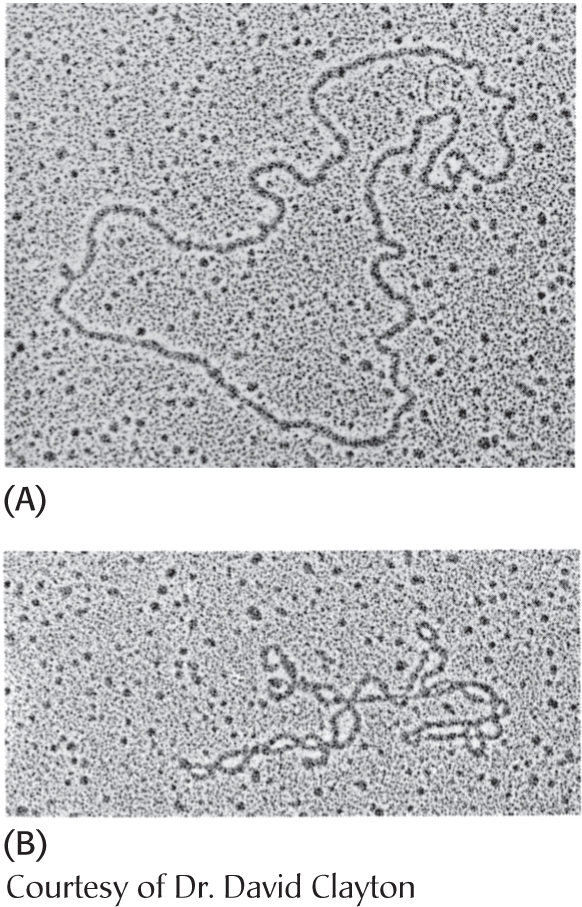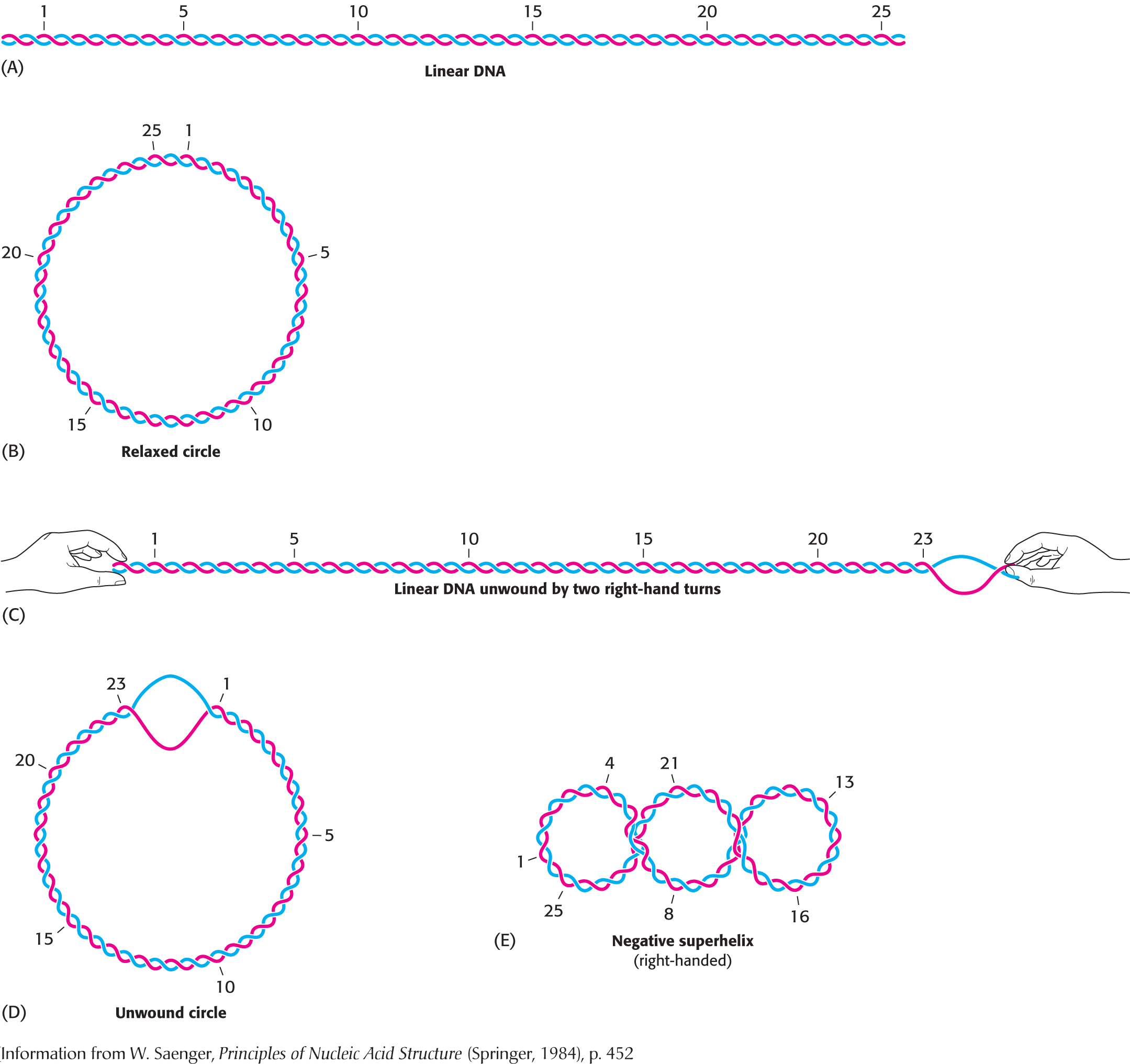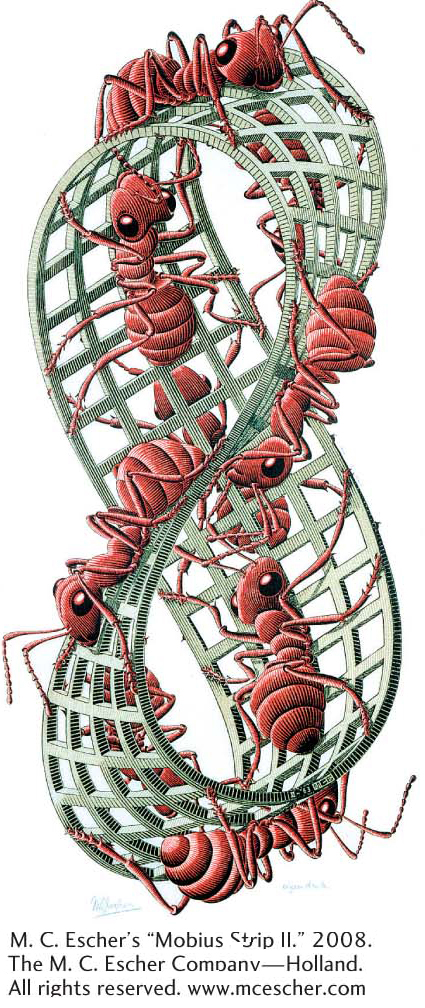33.3 DNA Double Helices Can Adopt Multiple Forms
The Watson-and-Crick model of DNA is called B-DNA. Under physiological conditions, most DNA is in the B form. However, this structure is not the only one that DNA can form. Studies of DNA revealed a different form called A-DNA, which appears when DNA is less hydrated. A-DNA, like B-DNA, is a right-handed double helix made up of antiparallel strands held together by Watson–Crick base-pairing. The A helix is wider and shorter than the B helix, and its base pairs are tilted rather than perpendicular to the helix axis (Figure 33.17).
Page 616
If the A helix were simply a property of dehydrated DNA, it would be of little significance. However, double-stranded regions of RNA and at least some RNA–DNA hybrids adopt a double-helical form very similar to that of A-DNA. As we will see, double-stranded regions of RNA and RNA–DNA hybrids are important players in RNA function and information processing.
Z-DNA Is a Left-Handed Double Helix in Which Backbone Phosphoryl Groups Zigzag
A third type of double helix is left-handed, in contrast with the right-handed screw sense of the A and B helices. Furthermore, the phosphoryl groups in the backbone are zigzagged; hence, this form of DNA is called Z-DNA (Figure 33.18).
Although the biological role of Z-DNA is still under investigation, Z-DNA–binding proteins, which have a highly conserved Z-DNA binding domain, are found in many organisms including humans. The existence of Z-DNA shows that DNA is a flexible, dynamic molecule whose parameters are not as fixed as depictions suggest. The properties of A-, B-, and Z-DNA are compared in Table 33.1.
The Major and Minor Grooves Are Lined by Sequence-Specific Hydrogen-Bonding Groups
An examination of the DNA molecule in the B form, as shown in Figure 33.17, reveals the presence of two distinct grooves, called the major groove and the minor groove. These grooves arise because the glycosidic bonds of a base pair are not diametrically opposite each other (Figure 33.19). In B-DNA, the major groove is wider (12 Å versus 6 Å) and deeper (8.5 Å versus 7.5 Å) than the minor groove (Figure 33.20).
Page 617
Each groove is lined by potential hydrogen-bond donor and acceptor atoms that enable interactions with proteins. These interactions are essential for replication and transcription because particular proteins bind to DNA, recognizing specific hydrogen-bond donors and acceptors on the surfaces of the grooves, to catalyze these processes (Chapters 34, 36, and 37). In the minor groove, N-3 of adenine or guanine and O-2 of thymine or cytosine can serve as hydrogen acceptors, and the amino group attached to C-2 of guanine can be a hydrogen donor. In the major groove, N-7 of guanine or adenine is a potential acceptor, as are O-4 of thymine and O-6 of guanine. The amino groups attached to C-6 of adenine and C-4 of cytosine can serve as hydrogen donors. The methyl group of thymine also lies in the major groove. Note that the major groove displays more features that distinguish one base pair from another than does the minor groove. The larger size of the major groove in B-DNA makes it more accessible for interactions with proteins that recognize specific DNA sequences.
Double-Stranded DNA Can Wrap Around Itself to Form Supercoiled Structures
Our earlier consideration of the amount of DNA in a cell raises an important question: How does all of the DNA fit inside a cell or a cell nucleus? The DNA molecules in human chromosomes are linear, while DNA molecules from some other organisms are circular (Figure 33.21A). DNA molecules inside cells necessarily have a very compact shape. Note that the E. coli chromosome, fully extended, would be about 1000 times as long as the greatest diameter of the bacterium.
Page 618
Bacterial chromosomes must therefore employ a new structural property to fit in the cell. The axis of the double helix can itself be twisted into a superhelix, a process called supercoiling (Figure 33.21B). Consider a linear 260-bp DNA duplex in the B-DNA form (Figure 33.22A). Because the number of residues per turn in a DNA molecule is 10.4, this linear DNA molecule has 25 (260/10.4) turns. The ends of this helix can be joined to produce a relaxed circular DNA (Figure 33.22B). A different circular DNA can be formed by unwinding the linear duplex by two turns before joining its ends (Figure 33.22C). What is the structural consequence of unwinding before ligation? Two limiting conformations are possible. First, the DNA can fold into a structure containing 23 turns of B helix and an unwound loop (Figure 33.22D). However, bases in the loop do not form base pairs, and base pairs stabilize the double helix; so this structure is somewhat unstable. The second structural possibility is for the DNA to adopt a supercoiled structure with 23 turns of B helix and 2 turns of right-handed (termed negative) superhelix (Figure 33.22E). In the superhelix, no bases are left unpaired. The unwound DNA and the supercoiled DNA are topological isomers, or topoisomers; that is, they have the same sequence but have different structures because of differences in the coiling of the DNA molecules (Figure 33.23). A supercoiled DNA molecule has a more compact shape than that of its relaxed counterpart.
Page 619
Most naturally occurring DNA molecules are negatively supercoiled. What is the basis for this prevalence? Negative supercoiling arises from the unwinding or underwinding of the DNA. In essence, negative supercoiling prepares DNA for processes requiring separation of the DNA strands, such as replication or transcription. Positive supercoiling condenses DNA as effectively, but it makes strand separation more difficult.
Supercoiling is a property not only of circular DNA. It also applies to linear DNA molecules that have a constrained configuration, such as when DNA is packaged into chromosomes (Section 33.4). The separation of the two strands of DNA in replication requires local unwinding of the double helix. This local unwinding must lead either to the overwinding of surrounding regions of DNA or to supercoiling. To prevent the strain induced by overwinding, a specialized set of enzymes is present to introduce supercoils that favor strand separation (Chapter 34).

